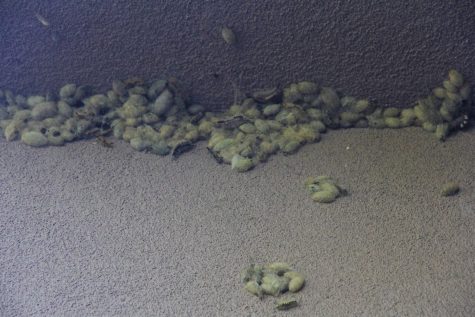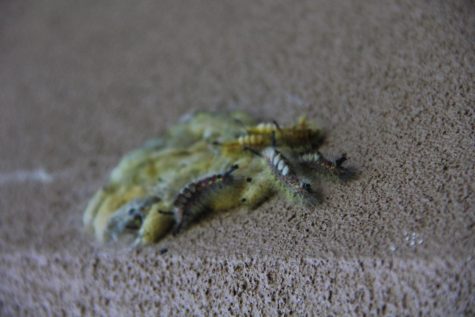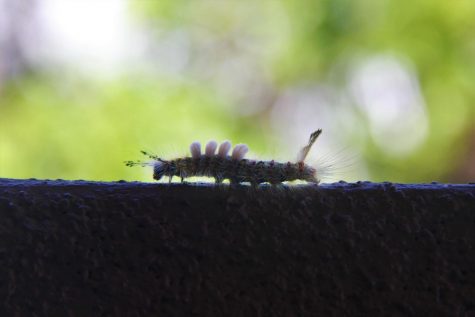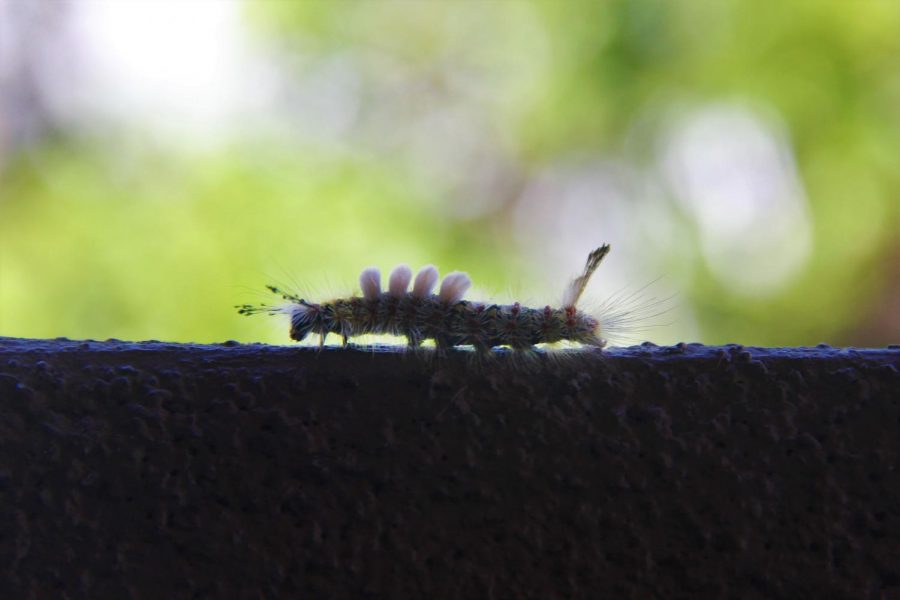Caterpillar population blooms, causing campus-wide discomfort
The population of Western tussock moth caterpillars on campus has exploded in size this spring—much to the disgust of many students and staff.
The appearance of the small, hairy caterpillar is a normal occurrence around the Bay Area this time of year, as they are native to the region. However, the population this year has grown so dramatically that it has been called the largest infestation in nearly twenty years. The enormity of their numbers was clearly seen at Gunn up until last weekend, when steps were taken to handle the infestation and the caterpillars were power-washed off of the N-Building, where most of them had cocooned.

Caterpillar cocoons accumulate outside of the N-building.
However, these caterpillars have proven themselves to be a hardy bunch. English teacher Paul Dunlap, whose classroom is located closest to the tree serving as the caterpillars’ habitat in the amphitheater, has experienced some of the worst of the infestation. After the power-washing, he noticed that the situation had improved, but the caterpillars were still coming back. “They start to lay eggs and reproduce, which they’re doing more quickly than they’re being removed,” he said. “I don’t know what will happen because I don’t know what their lifespan is, but they seem to be reproducing and coming back faster.”
 Melissa Ding
Melissa Ding
Dunlap also noticed that, while there had been caterpillars at Gunn nearly every year previously, this year was particularly bad. “It’s new for them to so completely take over an area,” he said. “Having them all around the windows—that hadn’t happened before. Usually they’re limited to the trees.”
Junior Carly Feng agrees that the infestation this year has been worse than others. According to Feng, the situation was especially apparent in the N-building. “They were everywhere on the roof and hallway,” she said. “I think that they even go into classrooms because they can crawl in through the cracks.”
 Melissa Ding
Melissa Ding
According to experts consulted by NBC news, the skyrocketing caterpillar population can be attributed to an increase in food supply and a decrease in predators and diseases that kill them. Their large numbers have made many students around school uncomfortable, as the hair on their bodies can irritate the skin and cause rashes. Oftentimes, the hairs travel with the wind, affecting students even when they never touch the caterpillars themselves.
Freshman Nalini Gunawardena’s dislike for the bugs stemmed from her negative experiences with them. “I was literally going up the stairs and I put my hand on the railing, and there were four caterpillars right there,” she said. “Some of my friends are more upset than others… a couple of people did say they got rashes from touching caterpillars.”
Dunlap holds similar feelings of enmity toward the caterpillars. “Before I hated them, I wanted to appreciate what they had to give to the cycle of life,” he said. “I have yet to hear a satisfying answer. We have so many crows, but they don’t come and eat them. So even the birds seem to know that they’re disgusting.”
Your donation will support the student journalists of Henry M. Gunn High School. Your contribution will allow us to purchase equipment and cover our annual website hosting costs.


